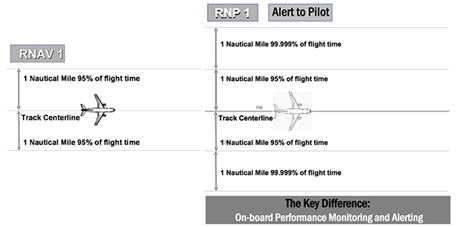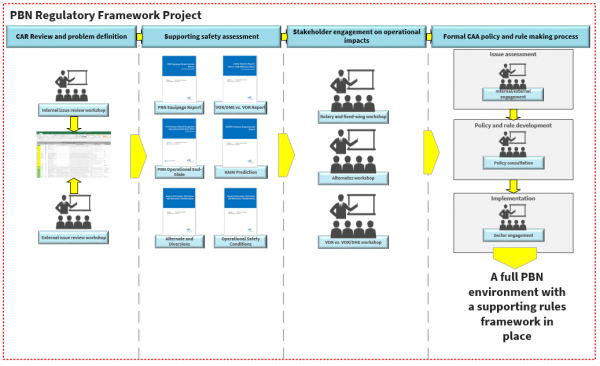Navigation
New Southern Sky and Performance Based Navigation
The introduction of navigation procedures that use accurate data from the Global Network of Satellite Systems (GNSS) is already delivering shorter, more direct flights.
Overview
Performance Based Navigation (PBN) moves aviation away from conventional ground-based navigation beacons to a system primarily reliant on satellite based technologies, which uses Global Navigation Satellite Systems (GNSS). Aligned with Australia, the GNSS system that New Zealand uses for IFR flights is the United States Global Positioning System (GPS).
PBN relies on GNSS equipment meeting specific perform specifications and standards. These standards, which are set by the International Civil Aviation Organisation (ICAO), are required because some systems do not provide the necessary accuracy, integrity, continuity or functionality to ensure flight safety in a PBN operating environment.
Unlike conventional ground-based navigation which focuses on the equipment installed on the aircraft, PBN focuses on the performance of the capability of the aircraft and how well the whole system performs. The performance requirements are identified as navigation specifications. A navigation specification can be a Required Navigation Performance (RNP) specification or an Area Navigation (RNAV) specification.

An example of Required Navigation Performance (RNP) through the various phases of flight
Why is New Zealand implementing PBN?
New Zealand has committed to supporting the ICAO PBN Initiative and the need for harmonised operations globally and within the New Zealand Flight Information Region (FIR). The use of PBN and the global harmonisation of navigation specifications (RNAV and RNP) will bring a range of benefits to operators and users of the system.
What are the benefits of PBN?
PBN is delivering a range of operational and other benefits. These include:
-
- Improved safety of enroute, terminal and approach operations;
- Improved operational efficiency;
- Reduced infrastructure costs;
- Increased airspace capacity;
- Reduced environmental impact through reduced emissions and potential to reduce exposure to noise.
What will a full PBN environment look like in New Zealand
By 2023, New Zealand will be operating in a full PBN environment. This means:
-
-
-
- Primary means Instrument Flight Rules (IFR) navigation will be based upon PBN.
- PBN will be predominantly based upon Global Navigation Satellite System (GNSS), using GPS.
- Routes and procedures will be based upon RNAV and RNP specifications
- Aircraft will also navigate using the RNAV and RNP specifications.
- Operators will require approval to conduct PBN operations. The approval process differs for Part 91 and Part 119 operators
- A regulatory framework will be in place to support and enable PBN operations
-
- This will include changes to alternate, fuel and equipage requirements.
- It will also see the removal of Part 19D IFR Operations: GNSS and Exemption 11/EXE/7
-
-
-
It will also mean:
-
-
-
- A reduced ground-based navigation infrastructure and associated procedures. However;
- A network of ground based navigation infrastructure will remain in place to support PBN. This is described as a Minimum Operating Network (MON), and it will:
-
-
-
-
- Comprise of strategically located VOR/DME navigation aids
- Support recovery operations in the event of aircraft failure or loss of GPS signal
- Support contingency operations for IFR Air Transport operations in the event of long-term loss of PBN (connectivity between Auckland, Wellington, and Christchurch)
- Routes and instrument flight procedures will be connected and optimised
- Where practicable, runway ends with PBN procedures will have Baro-VNAV to increase safety.
- Aircraft will be equipped with certified GPS receiver(s) which are installed in accordance with acceptable technical data (ATD), allowing them to take advantage of the safety and efficiency benefits provided through PBN
- Pilots and air traffic controllers will be competent and current in conducting and supporting PBN and conventional (GBNA based) operations.
- A limited conventional GBNA network and associated procedures (provided by the MON), will allow aircraft not equipped with PBN capability to navigate under IFR, conventionally
-
-
-
-
-
-
Operating in a PBN environment
To operate in a PBN environment, aircraft operators will need to be suitably equipped and trained. This means operators will need a PBN operational approval. AC 91-21 provides details on design standards and operating procedures required to obtain approval to conduct PBN operations. The Civil Aviation Authority is currently reviewing AC 91-21 with the objective of simplifying the approval process from a cost and time perspective.
Operational approval covers three elements:
-
-
- Aircraft capability: Operators must demonstrate that the aircraft is eligible for the navigation specification sought, and show that the instruments and equipment comply with one of the airworthiness options.
- Pilot training and qualifications: The applicant for operational approval must demonstrate that they have systems in place to ensure that pilots are appropriately trained in accordance with the applicable rule requirements
- Operator procedures: These procedures must be documented in an RNP and/or RNAV manual (as applicable), or as part of the operator’s exposition in the case of operations being conducted under Part 119.
-
RNP and RNAV navigation specifications
There are two types of PBN performance specifications that aircraft in New Zealand will navigate to; these are RNAV and RNP. RNAV and RNP allow aircraft to operate on routes independent of ground based navigation aids.
What makes RNP and RNAV the same?
The system defines navigation accuracy as being able to stay within the total system error at least 95% of the total flight time. This applies to BOTH RNAV and RNP. In the below example, with RNAV-1 or RNP-1, the aircraft will be within 1 nautical mile 95% of the flight time.
What makes RNP and RNAV different?
RNP requires on-board navigation performance monitoring and alerting. This means that the crew is alerted if the estimated accuracy of the aircraft's navigation system position fails to meet the required accuracy for the route or procedure. The system considers itself adequately contained as long as the probability of the aircraft being inside an area twice the total system error value at least 99.999% of the time. In the below example, with RNP 1, the aircraft will alert the pilot if there is a greater than 0.001% chance the aircraft could be more than 2 nautical miles off course.

Changes to Civil Aviation Rules
To support PBN, the CAA is modernising and future proofing PBN rules. This is being delivered under the PBN Regulatory Framework project.
Regulatory change is being delivered through a collaborative approach (see diagram below). This means the CAA are engaging with industry prior to the formal policy and Notice of Proposed Rule Making (NPRM) process. This ensures the CAA have a clear understanding of how regulatory changes may impact the diverse spectrum of operators and ensures rules are performance-based and future proofed, supporting all users of the system.

Civil Aviation rules review and problem definition
An assessment was made of the current civil aviation rules to identify any issues or areas which may impact the implementation of PBN in New Zealand. Issues identified ranged from minor definition changes to large scale rule projects relating to equipage and alternate requirements that will require significant input from within the CAA and industry. The CAA collaborated with stakeholders to understand which of the issues were high priority and needed to be addressed first, and which were low priority and could be addressed later.
Supporting safety assessments
To help define rule issues and support policy decision making, the CAA are delivering a range of safety assessments that may help support or inform rule outcomes under the PBN rules project. The recommendations from these reports are designed to identify the system safety considerations, including safe recovery of aircraft in the event of GNSS failure, RAIM prediction requirements, and equipage requirements. The safety assessments will assist in guiding the policy development process, but it is not binding and does not pre-judge the outcome of future work that is yet to be done.
Stakeholder engagement and operational impacts
The CAA’s focus will be on ensuring that the PBN rules framework creates a safe PBN environment that delivers the desired benefits. This includes understanding of the impact of safety assessment recommendations on stakeholders PBN operations; from commercial air transport operators, to operators of low performance aircraft, and air traffic controllers. A key element of this is the appropriate balancing of safety risk against operational considerations. The safety assessments and stakeholder workshop advice will feed into the formal CAA policy and rule making process
Formal CAA policy and rule making process
Any future PBN-related requirements in Civil Aviation Rules will be subject to the normal rulemaking process, with the in-depth sector consultation and Ministerial oversight that entails. In developing the regulatory framework, the CAA will continue to work closely with stakeholders to ensure that the impacts of possible changes are taken into account, and are part of advice given to decision-makers
Note that the NSS Website should not be considered as CAA Policy or Regulatory advice. Process advice provided here is for stakeholder guidance only.
What's been happening
News and Updates
Newly released, New Southern Sky’s benefits evaluation report
We're delighted to announce the release of the New Southern Sky - Benefits Evalu…
